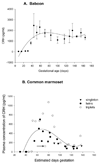Pattern of maternal circulating CRH in laboratory-housed squirrel and owl monkeys
- PMID: 20872786
- PMCID: PMC2947327
- DOI: 10.1002/ajp.20850
Pattern of maternal circulating CRH in laboratory-housed squirrel and owl monkeys
Abstract
The anthropoid primate placenta appears to be unique in producing corticotropin-releasing hormone (CRH). Placental CRH is involved in an endocrine circuit key to the production of estrogens during pregnancy. CRH induces cortisol production by the maternal and fetal adrenal glands, leading to further placental CRH production. CRH also stimulates the fetal adrenal glands to produce dehydroepiandrostendione sulfate (DHEAS), which the placenta converts into estrogens. There are at least two patterns of maternal circulating CRH across gestation among anthropoids. Monkeys examined to date (Papio and Callithrix) have an early-to-mid gestational peak of circulating CRH, followed by a steady decline to a plateau level, with a possible rise near parturition. In contrast, humans and great apes have an exponential rise in circulating CRH peaking at parturition. To further document and compare patterns of maternal circulating CRH in anthropoid primates, we collected monthly blood samples from 14 squirrel monkeys (Saimiri boliviensis) and ten owl monkeys (Aotus nancymaae) during pregnancy. CRH immunoreactivity was measured from extracted plasma by using solid-phase radioimmunoassay. Both squirrel and owl monkeys displayed a mid-gestational peak in circulating CRH: days 45-65 of the 152-day gestation for squirrel monkeys (mean±SEM CRH=2,694±276 pg/ml) and days 60-80 of the 133-day gestation for owl monkeys (9,871±974 pg/ml). In squirrel monkeys, circulating CRH declined to 36% of mean peak value by 2 weeks before parturition and then appeared to increase; the best model for circulating CRH over gestation in squirrel monkeys was a cubic function, similar to previous results for baboons and marmosets. In owl monkeys, circulating CRH appeared to reach plateau with no subsequent significant decline approaching parturition, although a cubic function was the best fit. This study provides additional evidence for a mid-gestational peak of maternal circulating CRH in ancestral anthropoids that has been lost in the hominoid lineage.
© 2010 Wiley-Liss, Inc.
Figures




Similar articles
-
Pattern of maternal serum corticotropin-releasing hormone concentration during pregnancy in the common marmoset (Callithrix jacchus).Am J Primatol. 2006 Feb;68(2):181-8. doi: 10.1002/ajp.20215. Am J Primatol. 2006. PMID: 16429419
-
Maternal and fetal hypothalamic-pituitary-adrenal axes during pregnancy and postpartum.Ann N Y Acad Sci. 2003 Nov;997:136-49. doi: 10.1196/annals.1290.016. Ann N Y Acad Sci. 2003. PMID: 14644820 Review.
-
Functions of corticotropin-releasing hormone in anthropoid primates: from brain to placenta.Am J Hum Biol. 2006 Jul-Aug;18(4):431-47. doi: 10.1002/ajhb.20521. Am J Hum Biol. 2006. PMID: 16788901 Review.
-
Corticotropin-releasing hormone-binding protein in primates.Am J Primatol. 2001 Mar;53(3):123-30. doi: 10.1002/1098-2345(200103)53:3<123::AID-AJP3>3.0.CO;2-V. Am J Primatol. 2001. PMID: 11253847
-
Elevated maternal plasma corticotropin releasing hormone levels in twin gestation.J Perinat Med. 1990;18(1):39-44. doi: 10.1515/jpme.1990.18.1.39. J Perinat Med. 1990. PMID: 2348330
Cited by
-
Anthropoid primate-specific retroviral element THE1B controls expression of CRH in placenta and alters gestation length.PLoS Biol. 2018 Sep 19;16(9):e2006337. doi: 10.1371/journal.pbio.2006337. eCollection 2018 Sep. PLoS Biol. 2018. PMID: 30231016 Free PMC article.
-
Measuring stress responses in female Geoffroy's spider monkeys: Validation and the influence of reproductive state.Am J Primatol. 2015 Sep;77(9):925-935. doi: 10.1002/ajp.22421. Epub 2015 Apr 17. Am J Primatol. 2015. PMID: 25891651 Free PMC article.
-
Comparative Immunohistochemistry of Placental Corticotropin-Releasing Hormone and the Transcription Factor RelB-NFκB2 Between Humans and Nonhuman Primates.Comp Med. 2015 Apr;65(2):140-3. Comp Med. 2015. PMID: 25926400 Free PMC article.
-
The physiological roles of placental corticotropin releasing hormone in pregnancy and childbirth.J Physiol Biochem. 2013 Sep;69(3):559-73. doi: 10.1007/s13105-012-0227-2. Epub 2012 Dec 29. J Physiol Biochem. 2013. PMID: 23385670 Review.
References
-
- Bassett JL, Foote SL. Distribution of corticotropin-releasing factor-like immunoreactivity in squirrel monkey (Saimiri sciureus) amygdala. J Comp Neurol. 1992;323:91–102. - PubMed
-
- Bowman ME, Lopata A, Jaffe RB, Golos TG, Wickings J, Smith R. Corticotropin-releasing hormone-binding protein in primates. Am J Primatol. 2001;53:123–130. - PubMed
-
- Campbell EA, Linton EA, Wolfe CD, Scraggs PR, Jones MT, Lowry PJ. Plasma corticotropin-releasing hormone concentrations during pregnancy and parturition. J Clin Endocrinol Metab. 1987;64:1054–1059. - PubMed
-
- Challis JRG, Matthews SG, Gibb W, Lye SJ. Endocrine and paracrine regulation of birth at term and preterm. Endocr Rev. 2000;21:514–550. - PubMed
Publication types
MeSH terms
Substances
Grants and funding
LinkOut - more resources
Full Text Sources

